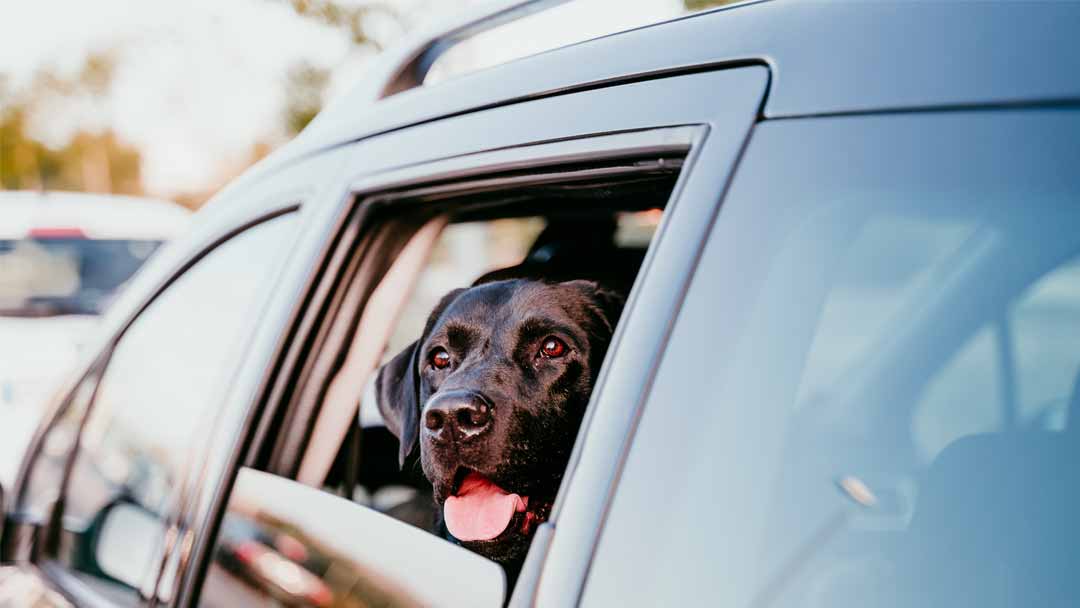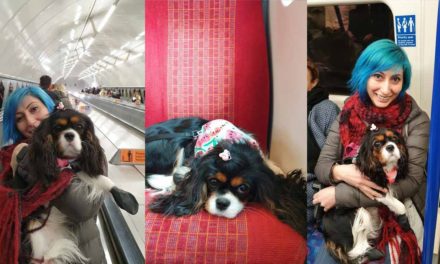Driving with dogs in the car safely
How to travel in the car with your dog
Driving with dogs safely is a little more than just taking them along with you. But there are laws and safety measures to consider. In the UK, your dog can travel with you in the car as long as it is safe to do so.
On this page we’ll be looking at how you can drive while keeping yourself and your dog safe. Rule of thumb is safety: both for the driver and the passenger dogs, plus a bit of common sense.
As long as your dogs are healthy enough for the journey and they are restrained properly with a dog seat belt, harness or pet carrier in the front or back seat or a in a crate, secured with a dog guard in the boot, you are complying with the law in the UK as you take precautions to avoid distractions while you’re driving the car and injury to the dogs in case of an accident.
WHAT’S THE UK LAW ON DRIVING WITH DOGS IN THE CAR?
Rule 57 of the Highway Code states:
“When in a vehicle make sure dogs or other animals are suitably restrained so they cannot distract you while you are driving or injure you, or themselves, if you stop quickly. A seat belt harness, pet carrier, dog cage or dog guard are ways of restraining animals in cars.”
If you fail to do so, not only you endanger your dog’s health as well as your own, you could also invalidate your car and pet insurances and even get fined for irresponsible driving.
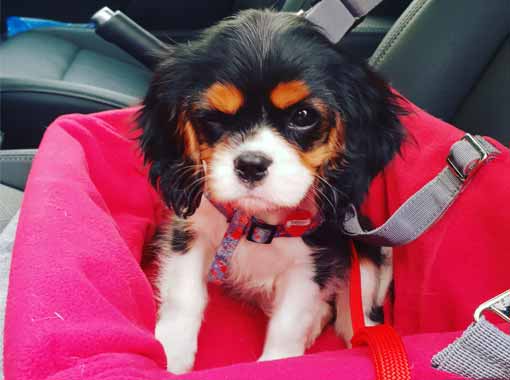
Our old car in the photo (Kia Rio) had a weight limit of 30 lbs (approx 13.6 kg) on the passenger side to activate the airbag so I didn’t need to adjust anything as she weighed way below that.
Since we got Lucy, we changed our car and as fully grown dogs, the combination of their weights (over 20 kg) is over the limit. Daisy and Lucy now travel in the back seat, on their individual dog car beds, secured with their individual dog car harnesses.
Scroll down to see how these equipments work while driving with dogs in the car.
Car safety for dogs: DOs and DON’Ts of driving with dogs
DO…
- Secure us using a harness and dog seat belt, carrier, booster seat or crate
- Keep a toy or blanket to comfort if we’re nervous
- Make sure we’re well hydrated, remember to take our water bottle
- Keep the car at a comfortable temperature, especially in the summer when it’s hot
- Take regular breaks on a long journey so we can stretch our legs and go to the toilet
- Ensure we’re are wearing ID tags wherever we go
- Pack a dog ramp if we’re less mobile and too heavy for you to lift
DON’T…
- Don’t feed us just before you travel or during the car journey, we might be sick, need the loo or even choke
- Don’t let the car overheat or get too cold
- Don’t allow us to ride with our heads hanging out the window, we love it but we could jump out or get hit by debris
- Don’t forget to disable the airbag if we’re travelling in the front seat
- Don’t ever leave us alone in the car, especially in the summer heat we could get a heatstoke so quickly
- Don’t listen to music too loud as our hearing is so much better than yours and it could disturb us
HOW TO SECURE A DOG IN THE CAR
It’s important to make the right choices to secure them while driving with dogs in the car, including a harness and seatbelt or a carrier / crate that is correct for their size and needs.
The harness shouldn’t be too tight but not too loose either so they can’t wriggle free. You should never attach the dog car seat belt to a neck collar either.
Even though many dogs would love to feel the breeze, you shouldn’t let them ride with their heads out of the window – you never know if they can jump out or get hit by something! Hanging their heads out of the window will cause you constant distraction while it will make them sneeze and cause their eyes to get dry and irritated.
If your dog’s clever like my Daisy to figure out how to open the windows, then keep the child lock on!
Other things to consider
Your dog’s temperament will be the guide to determine the type of car accessories you will need. Are they nervous in the car? Will they chew their way out of their harness? Perhaps a crate is a safer environment for your nervous dog to travel in, top of the travel crate covered by a blanket so they feel safe and secure in it.
Your dog’s size is also important when it comes to choosing the right dog car restraint to travel safely. Some dog car seats, also called dog car booster seats, come with built in straps to attach to a harness that will act as a dog seat belt but these are only suitable for small or medium size dogs while a big dog wouldn’t fit in or get comfortable in those. Again, if the a dog crate is your choice of equipment when transporting dogs in cars, then you need to make sure they have enough room inside to comfortably move around and the crate to be small enough to fit in your car.
Temperature is another main factor when you decide when to travel with your dogs. If it’s a hot summer’s day, you might want to travel in the morning or late afternoon or make sure the air conditioning is running and you invest in sun shades to travel with your dogs. In the winter make sure you have blankets to make sure your dog is warm and cosy or invest in winter clothing if your dogs can feel the cold like mine.
Dog car safety products
We’ve talked about how to secure your dog in the car safely, now let’s take a closer look at the dog car safety accessories we mentioned…
DOG CAR HARNESSES
Perhaps the easiest way to secure a dog in the car is with a dog harnesses. These are tougher than normal walking harnesses and the car’s seat belt can be attached to the harness to keep your dog safe.
Some harnesses will come with a seat belt, others will have a loop where you can slip your car’s seat belt through. This one will allow them more flexibility to move around in the back seat.
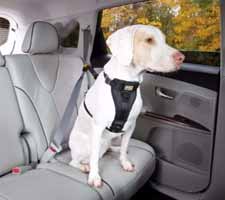
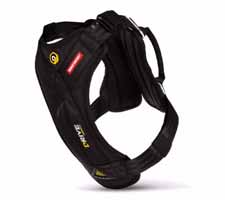
DOG CAR SEAT BELTS
Dog seat belts are fitted by attaching one end on your dog’s harness and the other end to your car’s seat belt lock. Make sure you choose one that has adjustable length for your dog’s size so you can make sure they have some room to move around.
Some seat belts can be secured to the head rest of the car seat with a lead that attaches to the car harness.
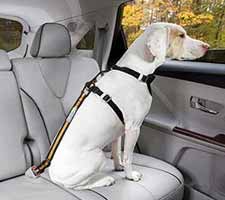
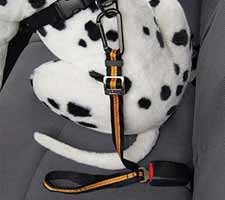
DOG CAR BOOSTER SEATS
For small and medium size dogs, a dog booster bed would be ideal to travel in. Not only these are secured to your car seat, your dog can be secured to the booster with its built in strap.
The height of the dog booster seat can be adjusted. You can raise it higher for smaller dogs so they can watch out of the window.
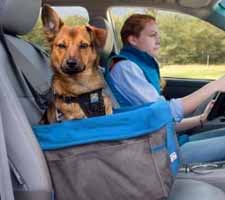
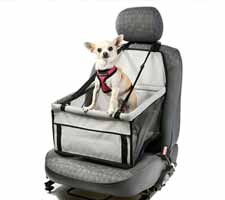
DOG CAR HAMMOCKS
Dog car seat covers and hammocks can provide extra comfort and help with keeping your car clean and dry – especially after wet and muddy walks and in case of accidents. You can hang both ends or leave the middle section between front and back seats down
Most hammocks come with dog seat belts, which are still needed.
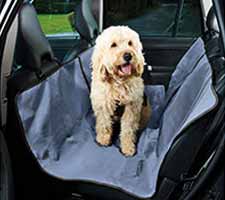
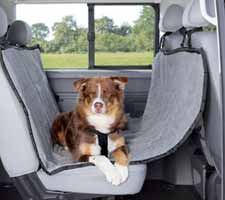
DOG CAR CRATES / CARRIERS
You can use a regular dog crate or a specially designed pet travel crate or cage inside or in the boot of your car. Make sure the crate is big enough for your pet to be able to move around in it as well as small enough to fit in your car.
We recommend using blankets inside the carriers or crates for comfort.
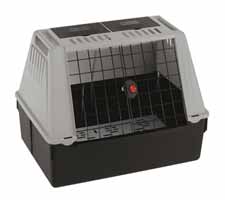
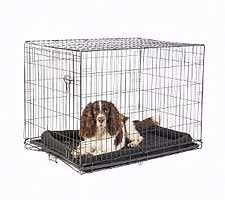
DOG GUARDS
You can fit a dog car guard between the boot and the back seat when carrying dogs in cars. Universal car dog barriers are easy to fit and will work in most cars.
These provide more room for dogs but are mainly used to prevent the dogs jumping inside the car so you will still need to make sure your dog’s safe and secure by using a harness and seat belt.
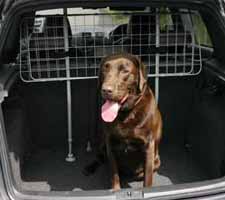
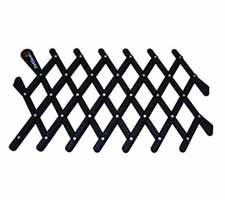
Product images courtesy of Pets at Home – thank you!
Frequently asked questions
We tried to answer some frequently asked questions about driving with dogs in the car. Please click on the title to read the answers to help you when you travel with your dogs:
Can I leave my dog in the car?
No. It’s not ok to leave your dog in a car alone under no circumstances.
In the summer, they can get a heaatstroke within minutes as the temperature inside a car is a lot higher than outside. You could be risking damage to your car too. I personally wouldn’t hesitate for a moment to break a window to rescue a dog left in a car in hot weather.
Although rare, small dogs can get hypothermia in very cold weather.
Dogs can be distressed by passer bys and they could even be stolen!
Please, don’t leave your dog in the car even for a few minutes. It could be a few minutes too long.
How long can you leave a dog in a car?
Please see above – you should never leave your dog unattended in a car.
The only acceptable situation where you can leave the dogs in the car is when you’re ready to drive off and putting something in the boot after securing your dogs first.
Are dogs allowed in the front seat of the car in the UK?
Yes they can but we don’t recommend it.
Firstly, you need to make sure that the dogs are safely restrained and the passenger side airbag is disabled as well as moving the seat back as much as you can. Some new cars have a weight limit to enable the airbags so if you have a small dog, you may not need to adjust any settings. Always refer to your car’s manual before you travel with a dog in the front seat.
If you have other people travelling with you in the front seat, you might forget enabling/disabling the airbag every time. That’s why we recommend you set up your back seat or your car boot for your dogs and leave the front seat to humans unless you absolutely have to.
How to stop my dog barking in the car?
There are many reasons why your dog might bark in the car but the most common three reasons are: Excessive excitement and anticipation of going somewhere, fear and anxiety or aggression and frustration stimulated by external factors such as passers by.
How to cure dog car anxiety
First you need to understand why your dog is barking in the car but teaching them the ‘wait’ command is a good start. Then you can just get them used to being in the car in your driveway or garage without driving away, with plenty of treats. Once this is achieved you can start with short rides, extending the journey time slowly.
If it’s excitement, surely your dog loves being in the car and can’t wait til you get to one of those amazing places you keep taking them! Lucy is an example of this but she usually settles once both herself and Daisy are strapped in with their car harness and seat belts and I resume the driving position. For excitable dogs, we recommend ignoring the barking until they settle.
Other than barking, you might be thinking why does my dog cry / shake / pant in the car. Well, some dogs associate being in the car with scary things. For example, if you have a nervous rescue dog like me, you’ll probably never know what they are scared of. How to calm a nervous dog in the car? It’s all about creating positive experiences. Lucy was an example of this. When we adopted her, she was scared of pretty much everything and the car wasn’t an exception. In her case, we think it’s being taken away from one scary place to another, plus never being in the car to go to do something fun.
The key to overcoming the car anxiety is building positive associations in your dog’s mind with car journeys. Get in the car, secure them with their dog car harness and seat belt, give treats for allowing this, then drive for a short period of time, only to come back to your house. See, nothing bad happened. Then extend the journey times that result in a positive experience – such as going to the park.
Barrier aggression or frustration is caused by external factors like people passing by, for example. Your dog might want to go say hello to them or try to protect you from the outsiders. I’ve observed this behaviour occasionally with Lucy where I think she was trying to protect us from the outsiders. There are two ways you can work with this behaviour. Either you can make them travel in a crate with a blanket over the top and sides so they can’t see the outside, just the inside of the car i.e. you in the front seat or you can work with your dog by parking somewhere where people will go past you and you feed them a treat every time someone walks past. Personally, I didn’t need to try either of these techniques but it was my plan if Lucy continued with the behaviour.
You can always get a dog behaviourist’s professional advice on how to train your dog to enjoy the car journeys.
How to stop my dog being car sick?
You’re settled in your car, driving nicely, then suddenly you notice them moving around uneasily, drooling and smacking their lips. Uh oh, here comes the vomit… Believe me, we’ve been there. So, why does my dog throw up in the car?
Firstly, it’s important to recognise the fact that some dogs can get motion sickness in the car. If your dog is one of those who suffer from car motion sickness, avoid feeding them before you drive – leave at least 2 hours between feeding your dog and the car journey.
Next thing to do is making them comfortable. Make sure they are safely secured and don’t get to move around much and that they are facing forward.
If it’s a long journey, make sure you take breaks often and to ventilate the car – fresh air always helps. It’s probably wise not to go on such long journeys before you get a chance to build your dog’s tolerance anyway.
When we adopted Lucy, she wasn’t used to car journeys, she was scared of everything and she would be sick every single time.
We took shorter journeys first, avoided feeding her just before we drive and protected our car with a dog car hammock as well as blankets we could easily wash. You should definitely invest in dog car seat covers or a hammock to keep your car clean anyway and they do help with the car sickness too.
How to stop dog car sickness naturally
If your dog doesn’t get used to travelling in the car without being sick, it might be time to seek natural remedies or your veterinarian’s advice. Do keep in mind that the healhier approach would be trying a natural approach before using prescribed medication.
Here’s a great article on how to stop dog car sickness naturally, recommending the use of herbs and tinctures as well as homeopathic remedies to ease motion sickness and anxiety.
How to keep a dog cool in a car
So how do you keep your dog cool while travelling in the car?
First of all, try to avoid car journeys in the hottest time of the day and try to travel early in the morning or late in the afternoon.
Then you should keep your car cool. Make sure you have the air conditioning on, or the fan, and keep the windows open at a safe degree so they can’t hang their heads out or jump out. Invest in sun shades for the summer. Always take care to cool the car first before you let the dogs in so parking in a shaded area is a good idea.
The next step is keeping your dogs cool and well hydrated. Always keep a bottle of water and a bowl with you. We use a stainless steel dog water bottle and its lid can be used as a bowl, really useful.
Cooling vests and cooling mats for dogs are very effective indeed. Make sure your dog doesn’t chew the mat and ingest any of the cooling gel in it though!
What we tend to do is, put on wet cooling suits and wet their heads before taking a journey in the car on a hot day. With air conditioning on, we rarely felt the need to use a cooling mat in the car but you do what you must to keep your dog cool.
How to remove dog hair / smell from car?
We use a dog car hammock on the back seat and can highly recommend it. It traps most of the dried mud and dog hairs and you can either hoover or shake off the dirt once the journey is over.
For dog hair, you can use pet lint rollers or even some packaging tape, it does the same job.
When the dirt is cleaned, you’ll find that most of the smell is gone.
If you have lingering bad odours in the car, avoid using car air fresheners because most artificial fragrances and even essential oil scents are toxic to dogs. Instead you can use baking soda (bicarbonate of soda) or a water/vinegar mixture.
Leave a bowl of baking soda in your car overnight and discard in the morning, you’ll notice that it absorbs most bad odours. You can use this trick in your smelly fridge too – you’re welcome 😉
Another way to neutralise bad odours in your car is to spray the upholstery with a mixture of vinegar and water in equal parts.
KEEP IN TOUCH
You can find us on Instagram. Follow us here: Instagram.com/travellingruff and say hello!
Alternatively, you can email us via the form below. Looking forward to hearing from you...

